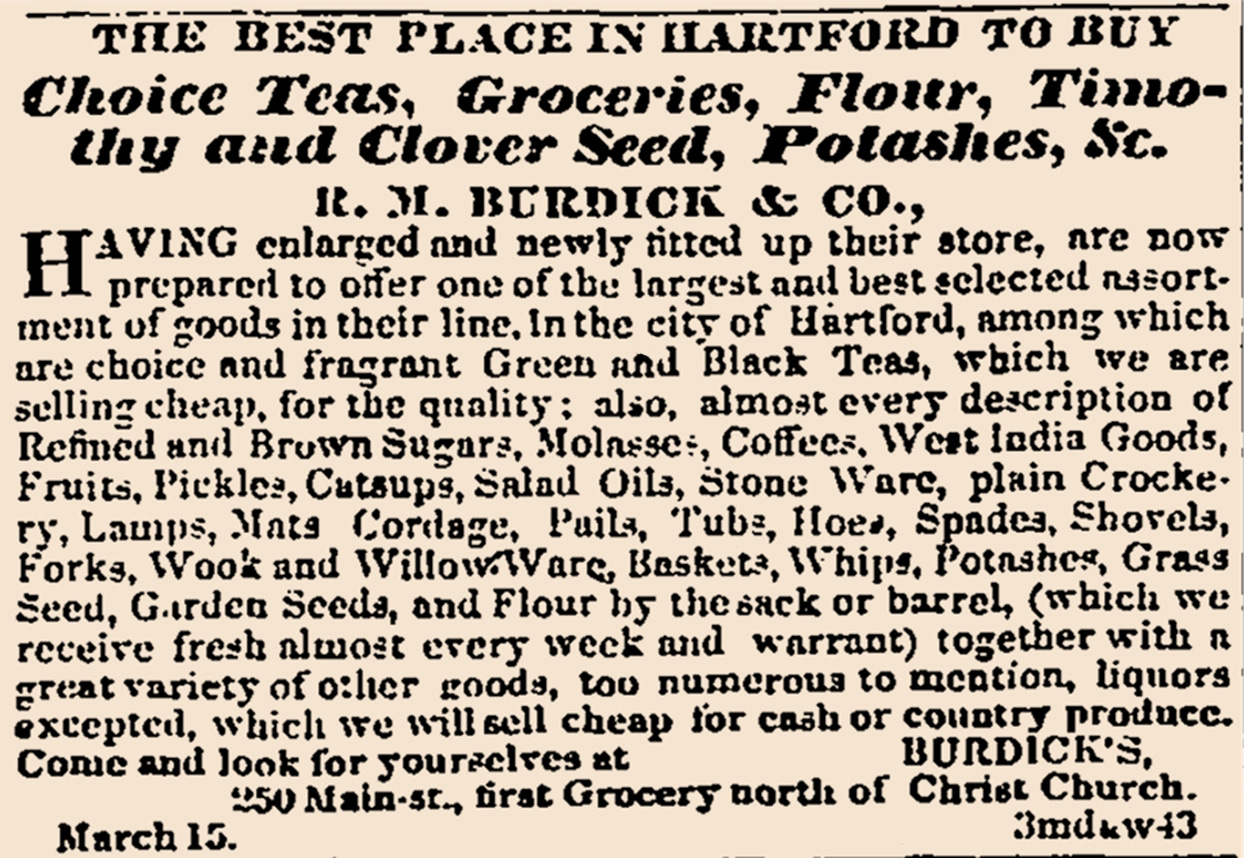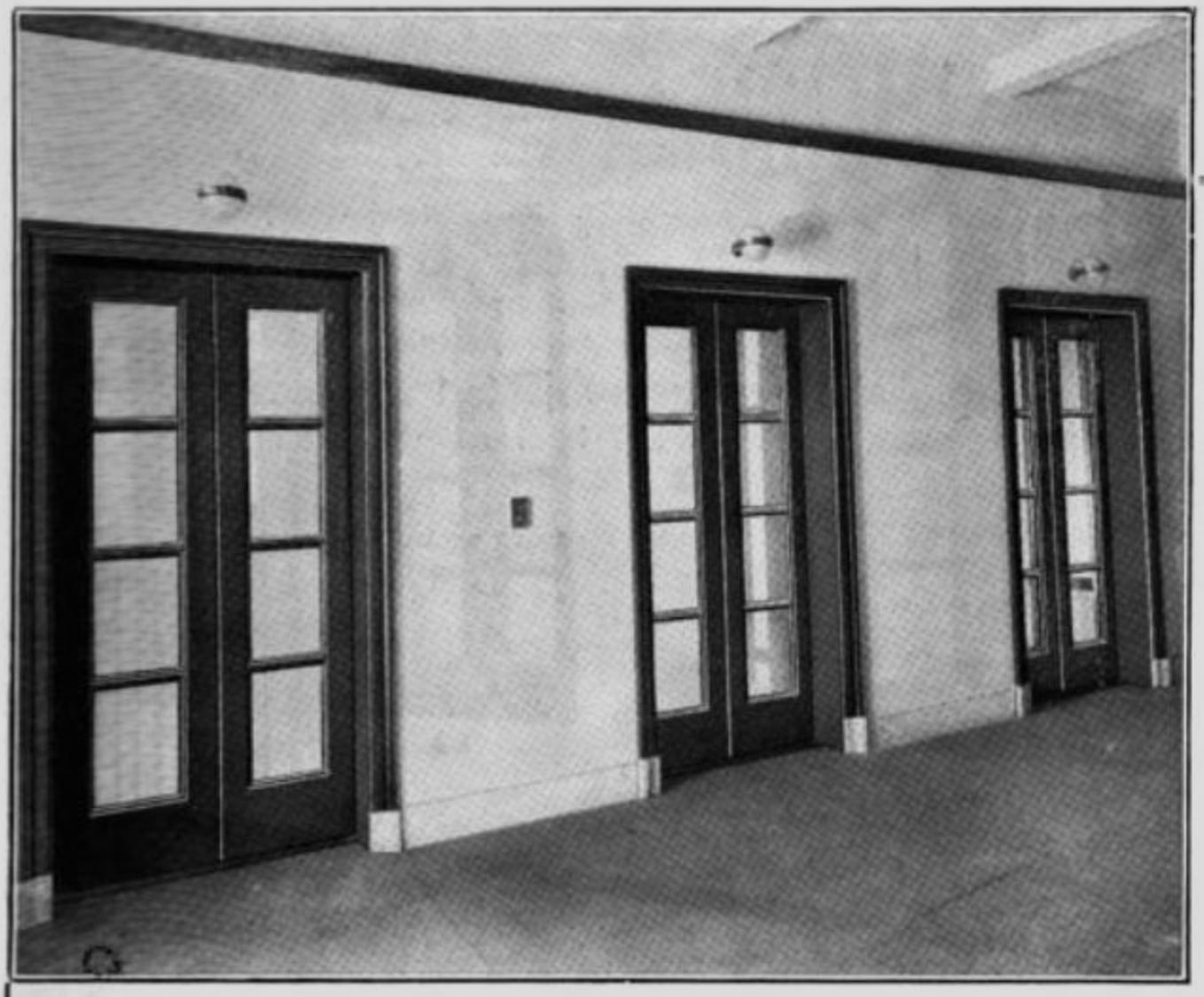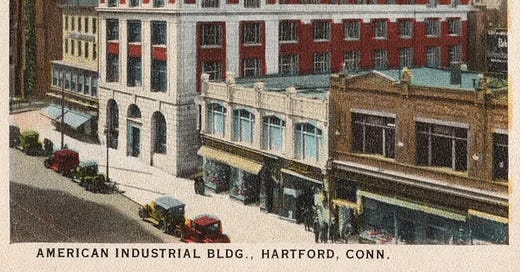Forgotten Office Tower: The American Industrial Building (1921-1974)
A Hartford landmark for over a half century came crashing down 50 years ago
The City of Hartford has a number of prominent tall buildings that fall into the category of skyscrapers, from the classic 527-foot, 24-story Travelers Tower (completed in 1919), which was the tallest building in New England until 1964, to later towers like the 535-foot, 38-story City Place I and the 522-foot, 30-story Goodwin Square, both built in the 1980s. The building that’s considered to have been the city’s first skyscraper, the 11-story Hartford-Aetna Building, was erected in 1912 for the Hartford National Bank at the corner of Main and Asylum Streets. Demolished in 1990, the Hartford National Bank Building was tallest structure downtown in 1912. In less than a decade, it was dwarfed with the rise of the nearby Travelers Tower in 1919. A year later witnessed the completion of the 246-foot, 18-story Hartford-Connecticut Trust Company Building at the corner of Main Street and Central Row. And just a year after that, in 1921, another tall office tower opened. A 211-foot, 16-story structure, it was referred to as a skyscraper at the time but would not be considered one today. Now lost, it stood a few blocks north of the Hartford National Bank and was called the American Industrial Building.
I mentioned it a while back in my YouTube video about buildings that used to exist where the so-called Stilts Building stands today, the area along the west side of Main Street at the north corner of Church Street.
The American Industrial Bank & Trust Company first opened its doors in 1913. Its offices were located in the southwest corner of the ground floor of the Travelers Insurance building, the entrance being just south of the primary entrance to Travelers on Main Street. In 1918, the growing bank, which had reached the milestone of two million dollars in deposits the previous year, acquired two adjacent properties on the west side of Main Street: a 4-story brick building at 981-983 Main and a 3-story brick building at 985-989 Main. It planned to build on this site as soon as its lease at Travelers expired.

981-989 Main Street Before the American Industrial Building
As often happened at the time, whenever old buildings that had a long history were slated for demolition, the Hartford Courant would run articles reflecting on their past occupants in the old days. The last retail occupant of the building at 981-983 Main Street was a branch of the Boston shoe store S. B. Thing & Company, but as the Courant reported on March 17, 1919, “It seems only yesterday to old residents when the Burdick brothers, Russell M. and William, ran a grocery store right where the S. B. Thing people are now making preparations to vacate.” After William died and Russell retired, the store was run by J. K. Wheeler and then the Dow brothers.

The adjacent building at 985-989 Main Street had also housed grocery stores at one time. As the Courant described it:
The store next north, now a saloon, has had many changes in proprietors. Among those best remembered were the grocers, J. H. Ranney and Chester G. Munyan. Others preceded and followed them, but the grocery stores finally pulled out and other businesses dropped in. The rooms overhead were occupied for business purposes and tenements. The Misses Hedigan occupied parlors there for dressmaking, having among their patrons some of the most particular people in the city.
The year 1897 was a difficult one for Miss Kate Hedigan. As the Courant reported on May 6, 1897, in the late winter she had slipped on the ice while walking on Church Street and was still confined to her bedroom during her recovery. As the paper reported: “The confinement is all the more annoying in that the busy season of her dressmaking department has come and nearly gone while she has been under the doctor’s care.”
The American Industrial Building Opens
Construction of the American Industrial Building began in early 1920. Before the end of the year, it was revealed that the American Industrial Bank & Trust itself would never occupy the rising structure. In December, the City Bank & Trust Company announced that it was acquiring the American Industrial’s banking assets. In 1921, the American Industrial Company dropped the words “Bank and Trust” from its name: it was now strictly a realty company operating its new 15-story office block. A bank would soon occupy the ground floor for a brief time however: the Phoenix National Bank would move in for about 14 months (November 1923 to June 1924) while its new headquarters was being erected further south on Main Street.
The general contractor for the American Industrial Building was William F. O’Neil (the same contractor who took down the steeple of the Pearl Street Congregational Church in 1899, as described in a recent video). O’Neil would be among the original renters of office space in the building. So far as I can find, an architect is not mentioned in any of the articles about the building in the Courant in 1920. Advertisements run in 1922 by the Dahlstrom Metallic Door Company of Jamestown, New York, which display its metal elevator doors used in the American Industrial Building, the architects are listed as Godley & Sedgwick. A year earlier, in January of 1921, with work on closing in the building underway, American Industrial announced that George Zunner of Hartford had been chosen as architect for the completion of the building. I don’t know the reason for this change of architect.

The Hartford Courant published the first photograph of the completed high rise on March 10, 1921, noting “The building from top to bottom was built and equipped entirely by local contactors showing conclusively that no matter how big the job, it can be done by Hartford contractors.” When the American Industrial Building formally opened that August, it was praised for the convenience of its location along Main Street, the abundance of natural light in its offices, and the speed of its three passenger elevators. As reported in the Courant on December 1, 1933, the building’s original manager, Herbert F. Fischer, who was then resuming his position after a hiatus, “pointed to the fact that the elevators in the building are said to be the fastest in New England.” On the roof was a penthouse of five rooms for the building’s superintendent. When the building opened there was also a large American flag flying high above Main Street.
Later Years and Demolition
By the late 1930s, the owners of the building had experienced financial trouble. The City Bank & Trust, which took over the property after a mortgage foreclosure, was itself in receivership in 1939 when it successfully petitioned a Superior Court judge to reduce the City of Hartford’s tax assessment on the building from $904,200 to $700,000 (although the receiver had sought a reduction to $500,000). For decades the building continued to be rented out to a variety of office tenants, as well as retailers on the ground floor like Kay Jewelers. In its later years the building was noted for having a tree growing on its roof.
The office tower was in the news on December 29, 1956, when the Courant reported that “Two young bubblegum-chewing girls,” aged 11 and 5, had got stuck in one of the building’s elevators. They had just been to a movie (presumably at the neighboring Strand Theater) and had gone up seeking a rest room. But when the door made an unusual sound they started pressing all the buttons, including the emergency stop. Stuck between floors, they banged their feet against the walls to attract attention and were eventually rescued by firemen, who removed the elevator’s wall panels. The girls were mostly afraid that their mothers would find out, but police took them home in time to watch the Mickey Mouse Club on TV.

As David S. Barrett reported in the Hartford Courant the following day, on the morning of Sunday, October 6, 1974, a crowd of 500-600 people gathered to watch the building be demolished. In preparation, the two structures just to the north, one of which was the city’s last downtown movie theater, the Strand, had already been taken down by traditional means. Jones Destruction Inc. of Farmington, the general contractor hired by the city to raze all three buildings, would take a different approach for the office tower. In only the second time explosives had been used to bring down a building in Hartford, the American Industrial was razed by the controlled explosion of 296 charges, carefully placed and timed by Controlled Demolition Inc. of Towson, Maryland, to guide its fall to the northwest, away from Main Street and Church Street. The nearby landmarks of Christ Church Cathedral and the G. Fox Building were undamaged, their windows having been carefully boarded up ahead of time. Traffic on I-84 was halted for about a half hour until the debris had been cleared and Main Street had been cleared off by the afternoon.
The American Industrial Building had stood for over a half-century and, I believe, for a time in the 1920s was the third tallest building downtown. If you enjoyed this article, please consider upgrading to a paid subscription to support my work. Let me know if you want more stories like this one.




